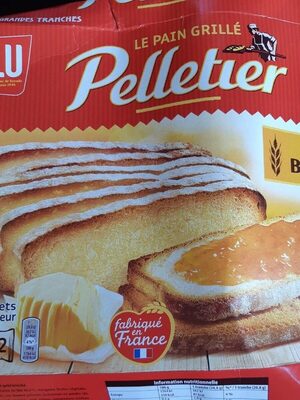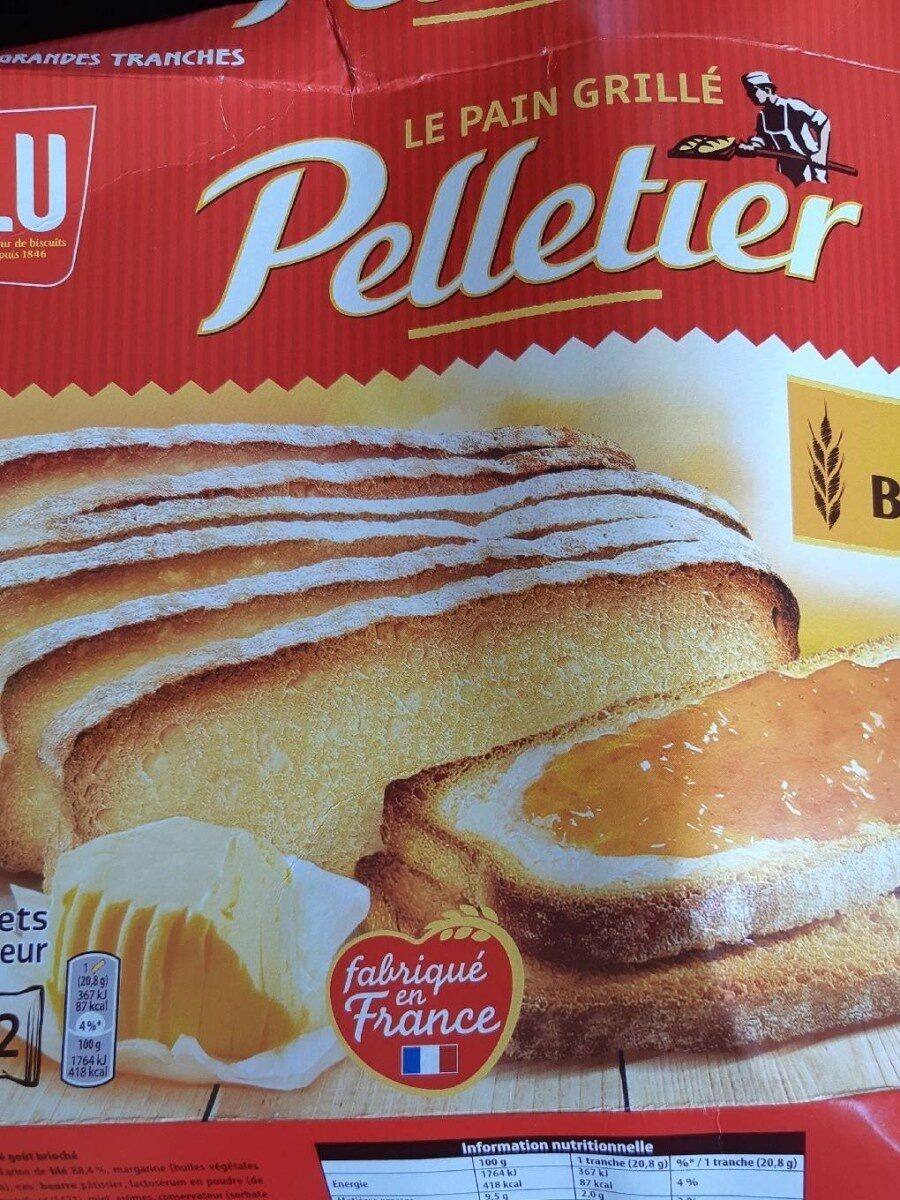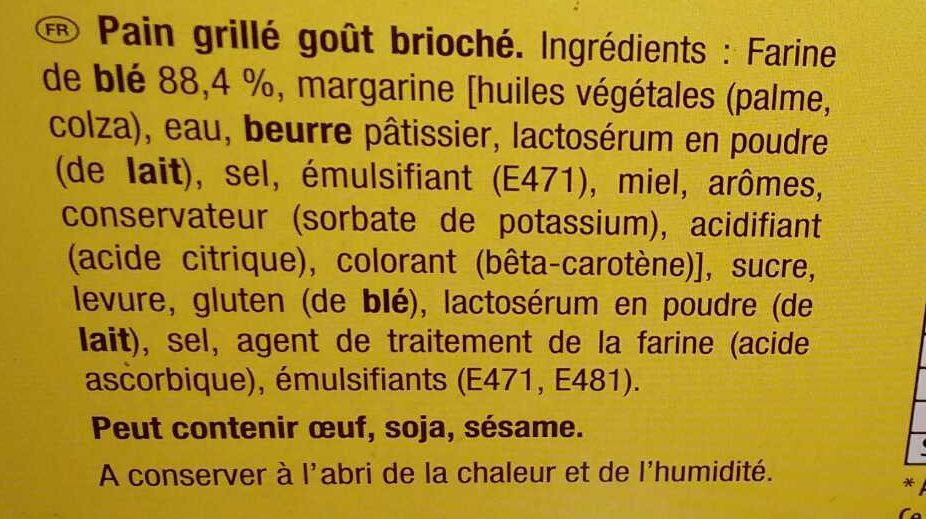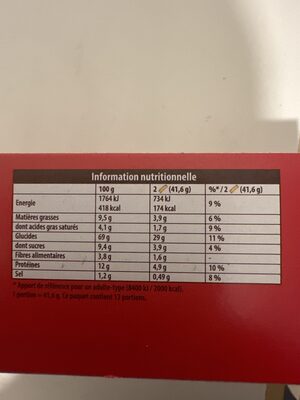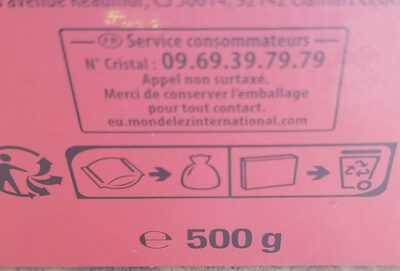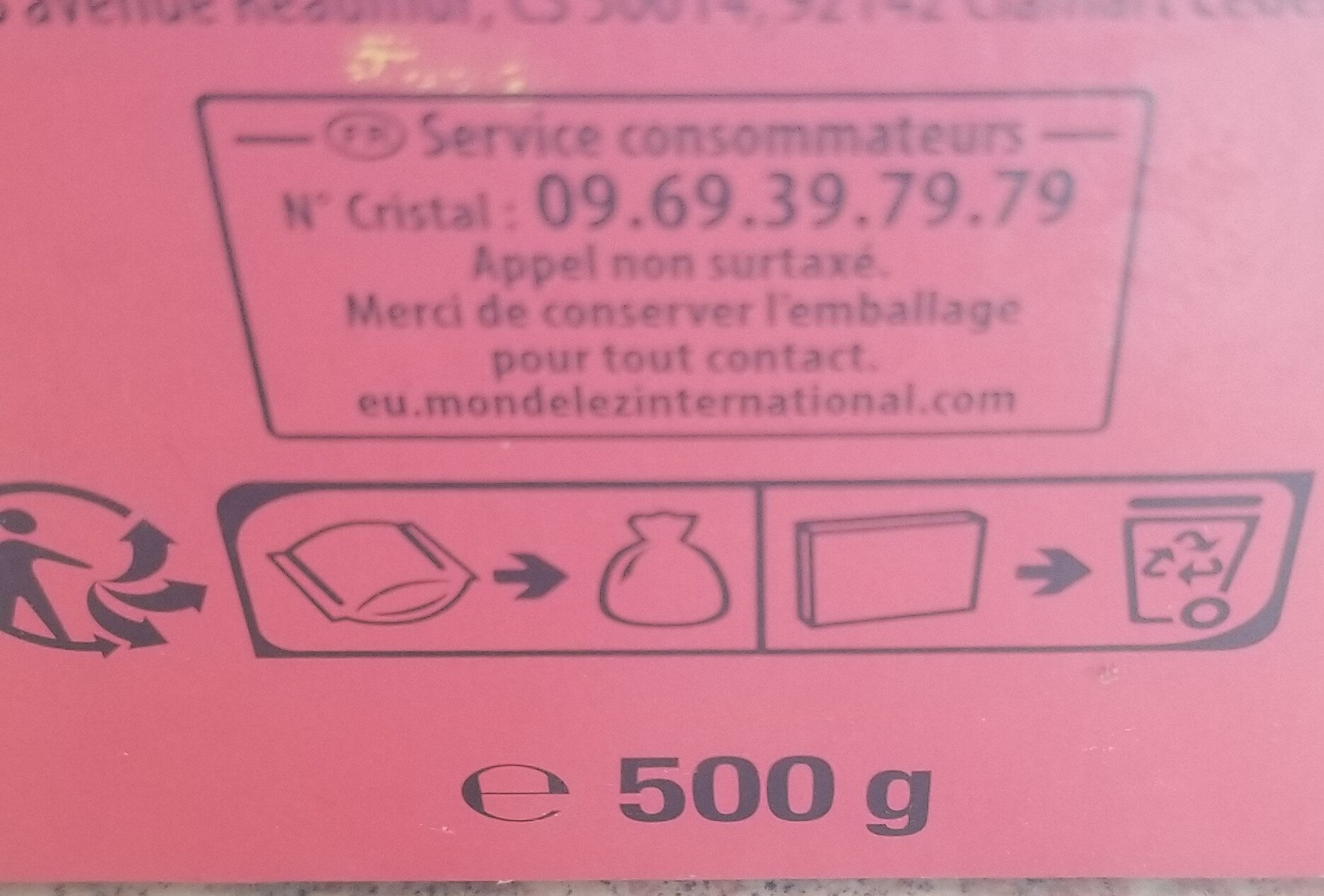Help us make food transparency the norm!
As a non-profit organization, we depend on your donations to continue informing consumers around the world about what they eat.
The food revolution starts with you!
Le pain grillier - Pelletier - 500 g e
Le pain grillier - Pelletier - 500 g e
This product page is not complete. You can help to complete it by editing it and adding more data from the photos we have, or by taking more photos using the app for Android or iPhone/iPad. Thank you!
×
Barcode: 7622210191830 (EAN / EAN-13)
Allgemengen Numm:: Le Pain Grillé Goût Brioché
Quantitéit: 500 g e
Verpackungsart: en:Plastic, en:Box, en:Cardboard
Kategorien: en:Plant-based foods and beverages, en:Plant-based foods, en:Cereals and potatoes, en:Breads, en:Toasts
Labelen, Zertifizéierungen, Auszeechnungen:
en:Green Dot, en:Made in France
Fabrikant oder Veraarbechtungsplaatz: France
Geschäfter: Magasins U, carrefour.fr
Country: Frankräich, Lëtzebuerg (Land)
Matching with your preferences
Health
Inhaltstoffer
-
28 ingredients
: Farine de blé 88,4 %, margarine [huiles végétales (palme, colza), eau, beurre pâtissier, lactosérum en poudre (de lait), sel, émulsifiant (E471), miel, arômes conservateur (sorbate de potassium), acidifiant (acide citrique), colorant (bêta-carotène)], sucre, levure, gluten (de blé), lactosérum en poudre (de lait), sel, agent de traitement de la farine (acide ascorbique), émulsifiants (E471, E481)Allergenen: en:Gluten, en:MilkTraces: en:Eggs, en:Sesame seeds, en:Soybeans
Food processing
-
Ultra processed foods
Elements that indicate the product is in the en:4 - Ultra processed food and drink products group:
- Zousätz: E160a
- Zousätz: E471
- Zousätz: E481
- Inhaltstoffer: Colour
- Inhaltstoffer: Emulsifier
- Inhaltstoffer: Gluten
- Inhaltstoffer: Wässeg
Food products are classified into 4 groups according to their degree of processing:
- Unprocessed or minimally processed foods
- Processed culinary ingredients
- Processed foods
- Ultra processed foods
The determination of the group is based on the category of the product and on the ingredients it contains.
Zousätz
-
E160a
Carotene: The term carotene -also carotin, from the Latin carota, "carrot"- is used for many related unsaturated hydrocarbon substances having the formula C40Hx, which are synthesized by plants but in general cannot be made by animals -with the exception of some aphids and spider mites which acquired the synthesizing genes from fungi-. Carotenes are photosynthetic pigments important for photosynthesis. Carotenes contain no oxygen atoms. They absorb ultraviolet, violet, and blue light and scatter orange or red light, and -in low concentrations- yellow light. Carotenes are responsible for the orange colour of the carrot, for which this class of chemicals is named, and for the colours of many other fruits, vegetables and fungi -for example, sweet potatoes, chanterelle and orange cantaloupe melon-. Carotenes are also responsible for the orange -but not all of the yellow- colours in dry foliage. They also -in lower concentrations- impart the yellow coloration to milk-fat and butter. Omnivorous animal species which are relatively poor converters of coloured dietary carotenoids to colourless retinoids have yellowed-coloured body fat, as a result of the carotenoid retention from the vegetable portion of their diet. The typical yellow-coloured fat of humans and chickens is a result of fat storage of carotenes from their diets. Carotenes contribute to photosynthesis by transmitting the light energy they absorb to chlorophyll. They also protect plant tissues by helping to absorb the energy from singlet oxygen, an excited form of the oxygen molecule O2 which is formed during photosynthesis. β-Carotene is composed of two retinyl groups, and is broken down in the mucosa of the human small intestine by β-carotene 15‚15'-monooxygenase to retinal, a form of vitamin A. β-Carotene can be stored in the liver and body fat and converted to retinal as needed, thus making it a form of vitamin A for humans and some other mammals. The carotenes α-carotene and γ-carotene, due to their single retinyl group -β-ionone ring-, also have some vitamin A activity -though less than β-carotene-, as does the xanthophyll carotenoid β-cryptoxanthin. All other carotenoids, including lycopene, have no beta-ring and thus no vitamin A activity -although they may have antioxidant activity and thus biological activity in other ways-. Animal species differ greatly in their ability to convert retinyl -beta-ionone- containing carotenoids to retinals. Carnivores in general are poor converters of dietary ionone-containing carotenoids. Pure carnivores such as ferrets lack β-carotene 15‚15'-monooxygenase and cannot convert any carotenoids to retinals at all -resulting in carotenes not being a form of vitamin A for this species-; while cats can convert a trace of β-carotene to retinol, although the amount is totally insufficient for meeting their daily retinol needs.Source: Wikipedia (Englesch)
-
E160ai
Beta-Carotene: β-Carotene is an organic, strongly colored red-orange pigment abundant in plants and fruits. It is a member of the carotenes, which are terpenoids -isoprenoids-, synthesized biochemically from eight isoprene units and thus having 40 carbons. Among the carotenes, β-carotene is distinguished by having beta-rings at both ends of the molecule. β-Carotene is biosynthesized from geranylgeranyl pyrophosphate.β-Carotene is the most common form of carotene in plants. When used as a food coloring, it has the E number E160a. The structure was deduced by Karrer et al. in 1930. In nature, β-carotene is a precursor -inactive form- to vitamin A via the action of beta-carotene 15‚15'-monooxygenase.Isolation of β-carotene from fruits abundant in carotenoids is commonly done using column chromatography. It can also be extracted from the beta-carotene rich algae, Dunaliella salina. The separation of β-carotene from the mixture of other carotenoids is based on the polarity of a compound. β-Carotene is a non-polar compound, so it is separated with a non-polar solvent such as hexane. Being highly conjugated, it is deeply colored, and as a hydrocarbon lacking functional groups, it is very lipophilic.Source: Wikipedia (Englesch)
-
E202
Potassium sorbate: Potassium sorbate is the potassium salt of sorbic acid, chemical formula CH3CH=CH−CH=CH−CO2K. It is a white salt that is very soluble in water -58.2% at 20 °C-. It is primarily used as a food preservative -E number 202-. Potassium sorbate is effective in a variety of applications including food, wine, and personal-care products. While sorbic acid is naturally occurring in some berries, virtually all of the world's production of sorbic acid, from which potassium sorbate is derived, is manufactured synthetically.Source: Wikipedia (Englesch)
-
E330 - Zitrounesaier
Citric acid: Citric acid is a weak organic acid that has the chemical formula C6H8O7. It occurs naturally in citrus fruits. In biochemistry, it is an intermediate in the citric acid cycle, which occurs in the metabolism of all aerobic organisms. More than a million tons of citric acid are manufactured every year. It is used widely as an acidifier, as a flavoring and chelating agent.A citrate is a derivative of citric acid; that is, the salts, esters, and the polyatomic anion found in solution. An example of the former, a salt is trisodium citrate; an ester is triethyl citrate. When part of a salt, the formula of the citrate ion is written as C6H5O3−7 or C3H5O-COO-3−3.Source: Wikipedia (Englesch)
-
E471
Mono- and diglycerides of fatty acids: Mono- and diglycerides of fatty acids -E471- refers to a food additive composed of diglycerides and monoglycerides which is used as an emulsifier. This mixture is also sometimes referred to as partial glycerides.Source: Wikipedia (Englesch)
-
E481
Sodium stearoyl lactylate: Sodium stearoyl-2-lactylate -sodium stearoyl lactylate or SSL- is a versatile, FDA approved food additive used to improve the mix tolerance and volume of processed foods. It is one type of a commercially available lactylate. SSL is non-toxic, biodegradable, and typically manufactured using biorenewable feedstocks. Because SSL is a safe and highly effective food additive, it is used in a wide variety of products ranging from baked goods and desserts to pet foods.As described by the Food Chemicals Codex 7th edition, SSL is a cream-colored powder or brittle solid. SSL is currently manufactured by the esterification of stearic acid with lactic acid and partially neutralized with either food-grade soda ash -sodium carbonate- or caustic soda -concentrated sodium hydroxide-. Commercial grade SSL is a mixture of sodium salts of stearoyl lactylic acids and minor proportions of other sodium salts of related acids. The HLB for SSL is 10-12. SSL is slightly hygroscopic, soluble in ethanol and in hot oil or fat, and dispersible in warm water. These properties are the reason that SSL is an excellent emulsifier for fat-in-water emulsions and can also function as a humectant.Source: Wikipedia (Englesch)
Analys vun den Inhaltstoffer
-
en:Palm oil
Ingredients that contain palm oil: en:Palm oil
-
en:Non-vegan
Non-vegan ingredients: en:Butterfat, en:Whey powder, Hunneg, en:Whey powderSome ingredients could not be recognized.
We need your help!
You can help us recognize more ingredients and better analyze the list of ingredients for this product and others:
- Edit this product page to correct spelling mistakes in the ingredients list, and/or to remove ingredients in other languages and sentences that are not related to the ingredients.
- Add new entries, synonyms or translations to our multilingual lists of ingredients, ingredient processing methods, and labels.
If you would like to help, join the #ingredients channel on our Slack discussion space and/or learn about ingredients analysis on our wiki. Thank you!
-
en:Vegetarian status unknown
Unrecognized ingredients: Margarin, fr:aromes-conservateurSome ingredients could not be recognized.
We need your help!
You can help us recognize more ingredients and better analyze the list of ingredients for this product and others:
- Edit this product page to correct spelling mistakes in the ingredients list, and/or to remove ingredients in other languages and sentences that are not related to the ingredients.
- Add new entries, synonyms or translations to our multilingual lists of ingredients, ingredient processing methods, and labels.
If you would like to help, join the #ingredients channel on our Slack discussion space and/or learn about ingredients analysis on our wiki. Thank you!
-
Details of the analysis of the ingredients
We need your help!
Some ingredients could not be recognized.
We need your help!
You can help us recognize more ingredients and better analyze the list of ingredients for this product and others:
- Edit this product page to correct spelling mistakes in the ingredients list, and/or to remove ingredients in other languages and sentences that are not related to the ingredients.
- Add new entries, synonyms or translations to our multilingual lists of ingredients, ingredient processing methods, and labels.
If you would like to help, join the #ingredients channel on our Slack discussion space and/or learn about ingredients analysis on our wiki. Thank you!
: Farine de _blé_ 88.4%, margarine (huiles végétales de palme, huiles végétales de colza, eau, beurre pâtissier, lactosérum en poudre, sel, émulsifiant (e471), miel, arômes conservateur (sorbate de potassium), acidifiant (acide citrique), colorant (bêta-carotène)), sucre, levure, gluten (de _blé_), _lactosérum_ en poudre, sel, agent de traitement de la farine (acide ascorbique), émulsifiants (e471, e481)- Farine de _blé_ -> en:wheat-flour - vegan: yes - vegetarian: yes - ciqual_proxy_food_code: 9410 - percent_min: 88.4 - percent: 88.4 - percent_max: 88.4
- margarine -> en:margarine - percent_min: 1.45 - percent_max: 11.6
- huiles végétales de palme -> en:palm-oil - vegan: yes - vegetarian: yes - from_palm_oil: yes - ciqual_food_code: 16129 - percent_min: 0.131818181818182 - percent_max: 11.6
- huiles végétales de colza -> en:colza-oil - vegan: yes - vegetarian: yes - from_palm_oil: no - ciqual_food_code: 17130 - percent_min: 0 - percent_max: 5.8
- eau -> en:water - vegan: yes - vegetarian: yes - ciqual_food_code: 18066 - percent_min: 0 - percent_max: 3.86666666666666
- beurre pâtissier -> en:butterfat - vegan: no - vegetarian: yes - from_palm_oil: maybe - ciqual_food_code: 16401 - percent_min: 0 - percent_max: 2.9
- lactosérum en poudre -> en:whey-powder - vegan: no - vegetarian: maybe - percent_min: 0 - percent_max: 2.32
- sel -> en:salt - vegan: yes - vegetarian: yes - ciqual_food_code: 11058 - percent_min: 0 - percent_max: 1.17
- émulsifiant -> en:emulsifier - percent_min: 0 - percent_max: 1.17
- e471 -> en:e471 - vegan: maybe - vegetarian: maybe - from_palm_oil: maybe - percent_min: 0 - percent_max: 1.17
- miel -> en:honey - vegan: no - vegetarian: yes - ciqual_food_code: 31008 - percent_min: 0 - percent_max: 1.17
- arômes conservateur -> fr:aromes-conservateur - percent_min: 0 - percent_max: 1.17
- sorbate de potassium -> en:e202 - vegan: yes - vegetarian: yes - percent_min: 0 - percent_max: 1.17
- acidifiant -> en:acid - percent_min: 0 - percent_max: 1.17
- acide citrique -> en:e330 - vegan: yes - vegetarian: yes - percent_min: 0 - percent_max: 1.17
- colorant -> en:colour - percent_min: 0 - percent_max: 1.05454545454545
- bêta-carotène -> en:e160ai - vegan: maybe - vegetarian: maybe - from_palm_oil: maybe - percent_min: 0 - percent_max: 1.05454545454545
- sucre -> en:sugar - vegan: yes - vegetarian: yes - ciqual_proxy_food_code: 31016 - percent_min: 0 - percent_max: 9.3
- levure -> en:yeast - vegan: yes - vegetarian: yes - percent_min: 0 - percent_max: 5.075
- gluten -> en:gluten - vegan: yes - vegetarian: yes - percent_min: 0 - percent_max: 3.38333333333333
- de _blé_ -> en:wheat - vegan: yes - vegetarian: yes - ciqual_proxy_food_code: 9410 - percent_min: 0 - percent_max: 3.38333333333333
- _lactosérum_ en poudre -> en:whey-powder - vegan: no - vegetarian: maybe - percent_min: 0 - percent_max: 2.5375
- sel -> en:salt - vegan: yes - vegetarian: yes - ciqual_food_code: 11058 - percent_min: 0 - percent_max: 1.17
- agent de traitement de la farine -> en:flour-treatment-agent - percent_min: 0 - percent_max: 1.17
- acide ascorbique -> en:e300 - vegan: yes - vegetarian: yes - percent_min: 0 - percent_max: 1.17
- émulsifiants -> en:emulsifier - percent_min: 0 - percent_max: 1.17
- e471 -> en:e471 - vegan: maybe - vegetarian: maybe - from_palm_oil: maybe - percent_min: 0 - percent_max: 1.17
- e481 -> en:e481 - vegan: maybe - vegetarian: maybe - from_palm_oil: maybe - percent_min: 0 - percent_max: 0.585
Ernährung
-
Poor nutritional quality
⚠ ️Warning: the amount of fruits, vegetables and nuts is not specified on the label, it was estimated from the list of ingredients: 1This product is not considered a beverage for the calculation of the Nutri-Score.
Positive points: 4
- Protéinen/Ëiweisser: 5 / 5 (value: 12, rounded value: 12)
- Fiber: 4 / 5 (value: 3.8, rounded value: 3.8)
- Fruits, vegetables, nuts, and colza/walnut/olive oils: 0 / 5 (value: 1.59829545454545, rounded value: 1.6)
Negative points: 16
- Energie: 5 / 10 (value: 1749, rounded value: 1749)
- Zocker: 2 / 10 (value: 9.3, rounded value: 9.3)
- Gesättescht Fetter: 4 / 10 (value: 4.1, rounded value: 4.1)
- Sodium: 5 / 10 (value: 468, rounded value: 468)
The points for proteins are not counted because the negative points are greater or equal to 11.
Nutritional score: (16 - 4)
Nutri-Score:
-
Nutrient levels
-
Fat in moderate quantity (9.5%)
What you need to know- A high consumption of fat, especially saturated fats, can raise cholesterol, which increases the risk of heart diseases.
Recommendation: Limit the consumption of fat and saturated fat- Choose products with lower fat and saturated fat content.
-
Saturated fat in moderate quantity (4.1%)
What you need to know- A high consumption of fat, especially saturated fats, can raise cholesterol, which increases the risk of heart diseases.
Recommendation: Limit the consumption of fat and saturated fat- Choose products with lower fat and saturated fat content.
-
Sugars in moderate quantity (9.3%)
What you need to know- A high consumption of sugar can cause weight gain and tooth decay. It also augments the risk of type 2 diabetes and cardio-vascular diseases.
Recommendation: Limit the consumption of sugar and sugary drinks- Sugary drinks (such as sodas, fruit beverages, and fruit juices and nectars) should be limited as much as possible (no more than 1 glass a day).
- Choose products with lower sugar content and reduce the consumption of products with added sugars.
-
Salt in moderate quantity (1.17%)
What you need to know- A high consumption of salt (or sodium) can cause raised blood pressure, which can increase the risk of heart disease and stroke.
- Many people who have high blood pressure do not know it, as there are often no symptoms.
- Most people consume too much salt (on average 9 to 12 grams per day), around twice the recommended maximum level of intake.
Recommendation: Limit the consumption of salt and salted food- Reduce the quantity of salt used when cooking, and don't salt again at the table.
- Limit the consumption of salty snacks and choose products with lower salt content.
-
-
Ernährungangaben
Ernährungangaben As sold
for 100 g / 100 mlAs sold
per serving (20,8 g)Compared to: en:Breads Energie 1.749 kj
(418 kcal)364 kj
(86 kcal)+34 % Fat 9,5 g 1,98 g +58 % Saturated fat 4,1 g 0,853 g +215 % Carbohydrates 69 g 14,4 g +39 % Sugars 9,3 g 1,93 g +184 % Fiber 3,8 g 0,79 g -29 % Protein 12 g 2,5 g +25 % Salt 1,17 g 0,243 g -9 % Fruits‚ vegetables‚ nuts and rapeseed‚ walnut and olive oils (estimate from ingredients list analysis) 1,598 % 1,598 %
Environment
-
Eco-Score B - Low environmental impact
The Eco-Score is an experimental score that summarizes the environmental impacts of food products.→ The Eco-Score was initially developped for France and it is being extended to other European countries. The Eco-Score formula is subject to change as it is regularly improved to make it more precise and better suited to each country.Life cycle analysis
-
Average impact of products of the same category: A (Score: 92/100)
Kategorie: Wheat swedish toast
Kategorie: Wheat swedish toast
- PEF environmental score: 0.18 (the lower the score, the lower the impact)
- including impact on climate change: 1.27 kg CO2 eq/kg of product
Stage Impact Agriculture
66.6 %Processing
20.6 %Verpackungsart
6.1 %Transportation
6.3 %Distribution
0.4 %Consumption
0.0 %
Bonuses and maluses
-
Missing origins of ingredients information
Malus: -5
⚠ ️ The origins of the ingredients of this product are not indicated.
If they are indicated on the packaging, you can modify the product sheet and add them.
If you are the manufacturer of this product, you can send us the information with our free platform for producers.
-
Ingredients that threatens species
Malus: -10
Contains palm oil
Tropical forests in Asia, Africa and Latin America are destroyed to create and expand oil palm tree plantations. The deforestation contributes to climate change, and it endangers species such as the orangutan, the pigmy elephant and the Sumatran rhino.
-
Packaging with a medium impact
Malus: -11
Shape Material Recycling Impact Box Plastic Héich Unknown Cardboard Low ⚠ ️ The information about the packaging of this product is not sufficiently precise (exact shapes and materials of all components of the packaging).⚠ ️ For a more precise calculation of the Eco-Score, you can modify the product page and add them.
If you are the manufacturer of this product, you can send us the information with our free platform for producers.
Eco-Score for this product
-
Impact for this product: B (Score: 66/100)
Produkt: Le pain grillier - Pelletier - 500 g e
Life cycle analysis score: 92
Sum of bonuses and maluses: -26
Final score: 66/100
-
Carbon footprint
-
Equal to driving 0.7 km in a petrol car
127 g CO² per 100g of product
The carbon emission figure comes from ADEME's Agribalyse database, for the category: Wheat swedish toast (Source: ADEME Agribalyse Database)
Stage Impact Agriculture
64.8 %Processing
15.4 %Verpackungsart
8.7 %Transportation
10.8 %Distribution
0.4 %Consumption
0.0 %
Verpackungsart
-
Packaging with a medium impact
-
Packaging parts
Box (Plastic)
(Cardboard)
-
Packaging materials
Material % Packaging weight Packaging weight per 100 g of product Paper or cardboard Plastic Total
-
Transportation
-
Origins of ingredients
Missing origins of ingredients information
⚠ ️ The origins of the ingredients of this product are not indicated.
If they are indicated on the packaging, you can modify the product sheet and add them.
If you are the manufacturer of this product, you can send us the information with our free platform for producers.Add the origins of ingredients for this product Add the origins of ingredients for this product
Threatened species
-
Contains palm oil
Drives deforestation and threatens species such as the orangutan
Tropical forests in Asia, Africa and Latin America are destroyed to create and expand oil palm tree plantations. The deforestation contributes to climate change, and it endangers species such as the orangutan, the pigmy elephant and the Sumatran rhino.
Report a problem
-
Incomplete or incorrect information?
Category, labels, ingredients, allergens, nutritional information, photos etc.
If the information does not match the information on the packaging, please complete or correct it. Open Food Facts is a collaborative database, and every contribution is useful for all.
Data sources
Product added on vun openfoodfacts-contributors
Last edit of product page on vun smoothie-app.
Produkt Säit och geännert vun beniben, date-limite-app, driveoff, ecoscore-impact-estimator, inf, kiliweb, magasins-u, packbot, quechoisir, scanbot, yuka.U29VWUliNHEvc0U0dXNRZ3dESDJ4TnRZNTV5dmIxdUljczB4SVE9PQ, yuka.VktRd0ZZRS9qL2dqd2NWaDhBdjg4TmRabUkrR1pVQ2xOOW9WSWc9PQ, yuka.YUx3dkZJZ0crOE1idmZjMytoK0sxSWh3L0pPeGRtT1dkZEFESWc9PQ, yuka.YktzSE40b2ppT3NEaE05ajhoWDZ4dGxMMklXSVlFNjRMc1FmSWc9PQ, yuka.sY2b0xO6T85zoF3NwEKvlkpgbYPa_W3FPCTgl02F_8elKaXjedd1_LraGqs, yuka.sY2b0xO6T85zoF3NwEKvlmtlXovgsjbuPCbQvHOFn42ndrnvX8BiuZj4Fas, yukafix.
